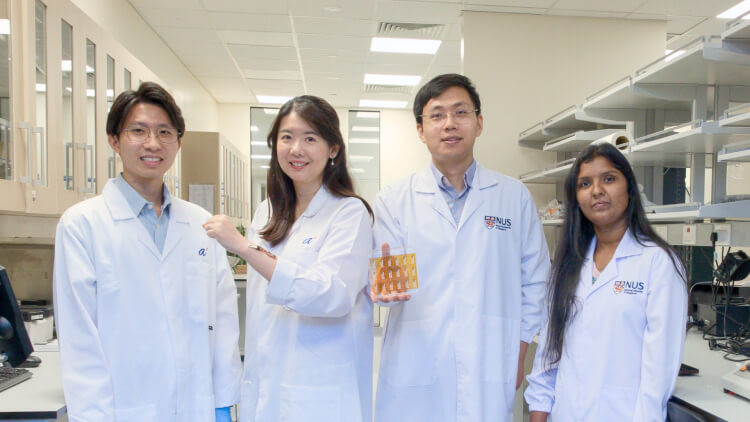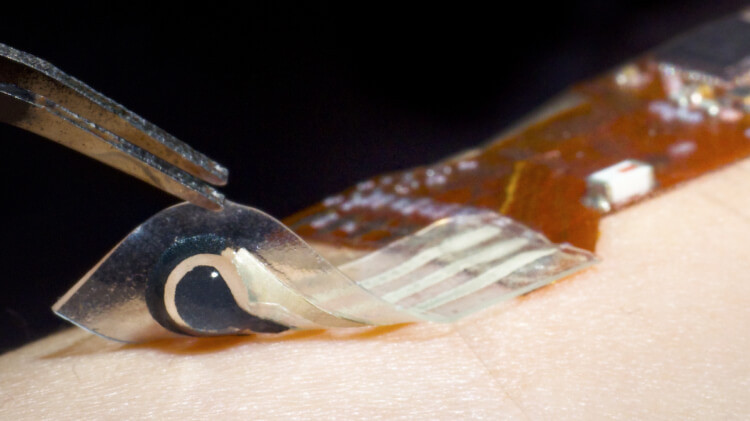New Sensor Detects Cholesterol and Glucose from Skin Efficiently
Insights | 10-09-2024 | By Robin Mitchell

Asst Prof Liu Yuxin (second from right) from the NUS Institute for Health Innovation & Technology (iHealthtech) and Department of Biomedical Engineering, NUS College of Design and Engineering; Dr Yang Le (second from left), Principal Scientist and Head of the Sensors and Flexible Electronics Department at A*STAR’s Institute of Materials Research and Engineering (IMRE); Mr Sherwin Tan (far left), Research Engineer at A*STAR’s IMRE; and Ms Archana Sundarapandi, Research Engineer at NUS iHealthtech, were part of the team that developed a wearable sensor capable of detecting biomarkers like cholesterol and lactate directly from the skin. Photo: NUS iHealthtech
A groundbreaking innovation in health technology has emerged with the development of a stretchable, hydrogel-based sensor capable of detecting cholesterol, lactate, and glucose directly from the skin. This non-invasive method, created by researchers from the National University of Singapore and A*Star, opens new possibilities for chronic disease management and remote patient monitoring. By eliminating the need for invasive blood tests, this sensor could significantly transform health monitoring practices.
Key Things to Know:
- The stretchable, hydrogel-based sensor offers a non-invasive method to detect key biomarkers like cholesterol, lactate, and glucose directly from the skin.
- By eliminating the need for invasive blood tests, this sensor greatly improves chronic disease management and remote patient monitoring.
- Recent research shows a strong correlation between biomarkers on the skin and blood, indicating this sensor's potential to replace traditional blood tests.
- The integration of this sensor with wearable devices is expected to drive growth in the medical wearables market, projected to reach $427 billion by 2032.
What challenges do medical sensors face when monitoring glucose and cholesterol, how does this new sensor's technology work to detect biomarkers on dry skin, and how might the integration of this sensor with wearable devices impact the future of health monitoring and medical diagnostics?
Monitoring Medical Markers: Overcoming the Challenges of Glucose and Cholesterol Detection
As the human body is comprised of many different types of tissue, monitoring specific medical markers such as glucose and cholesterol comes with a range of difficulties. When it comes to monitoring glucose, for example, the use of invasive sensors that directly monitor the levels of glucose in the blood is the most accurate method, but this also introduces the risk of infection and secondary bacterial infection. The need to pierce the skin also introduces bleeding as blood vessels break, and this can further lead to clots. Thus, engineers have focused on the use of non-invasive methods that take advantage of light and the way it interacts with tissue.
However, non-invasive methods for monitoring glucose and cholesterol also come with their own range of issues. In the case of glucose monitoring, light can only be used on the surface of the skin, and this means that fatty tissue can interfere with the ability to accurately read glucose levels. In the case of cholesterol, direct monitoring of cholesterol in blood is also problematic as blood needs to be drawn into a vial. The need for a large sample size introduces invasiveness, and the need for laboratory conditions to read the results introduces a long delay. Engineers have been able to find workarounds, but the challenges presented by monitoring such medical markers continue to present engineers with a range of difficulties.
Challenges in Non-Invasive Glucose and Cholesterol Monitoring
The importance of monitoring glucose and cholesterol levels cannot be understated when considering their impact on chronic diseases. As such, frequent testing is required to ensure that healthcare professionals can keep a tab on such markers. However, relying on traditional blood tests introduces two major issues; invasiveness and discomfort. The use of needles to extract blood samples not only causes temporary pain, but also introduces the risk of infection and increased anxiety in patients.
The challenges don't end there, as current non-invasive sensors face numerous difficulties that make them unreliable. To start, environmental factors such as temperature and humidity can affect the sensors performance, resulting in inaccurate readings. Furthermore, the unique characteristics of each individual's skin also presents challenges to sensors, with pigmentation, wrinkles, and hair growth all influencing sensor performance.
To make matters worse, existing technologies also struggle with detecting low levels of biomarkers, thereby impacting their sensitivity and specificity. This means that sensors may fail to detect changes in glucose and cholesterol levels, resulting in incorrect diagnoses. Overall, current testing methods are not only unpleasant, but also unreliable and limited in their ability to detect subtle changes in biomarkers.
The Future of Health Monitoring: A New Era of Comfort and Accuracy
The development of a stretchable, hydrogel-based sensor that can detect cholesterol, lactate, and glucose levels from the skin marks a significant advancement in health technology. This non-invasive method, developed by researchers from the National University of Singapore and A*Star, has the potential to greatly improve chronic disease management and remote patient monitoring by eliminating the need for invasive blood tests. The sensor's ability to detect solid-state biomarkers on dry skin enhances comfort and accuracy, adapting to the skin's natural elasticity and elasticity of the sensor.
Building on this innovative approach, the ability to detect solid-state biomarkers directly from the skin holds tremendous potential for improving the management of chronic conditions like diabetes and cardiovascular disease. As highlighted in recent studies, continuous monitoring through non-invasive sensors reduces patient discomfort and enhances long-term adherence to monitoring protocols, particularly for conditions requiring frequent testing. Furthermore, advancements in hydrogel technology ensure these sensors remain flexible and functional even during prolonged usage, maintaining accuracy across different physiological conditions.
The sensor technology utilises hydrogels that dissolve and diffuse solid-state epidermal biomarkers, which then undergo electrochemical reactions catalyzed by enzymes. The transfer of electrons to an electronically conductive hydrogel enables wireless data transmission to the user, offering real-time monitoring of physiological parameters. Clinical studies have shown strong correlations between biomarkers on the skin and those in blood samples, indicating the sensor's potential as an alternative to blood tests for monitoring chronic diseases such as diabetes and cardiovascular conditions.

The sensor consists of an ionic electronic bilayer hydrogel that detects solid-state biomarkers from the skin. It is connected to a flexible printed circuit board, which wirelessly transmits data to a user interface. Photo: NUS iHealthtech
Innovative Use of Hydrogels for Real-Time Biomarker Monitoring
Researchers from the National University of Singapore (NUS) and A*STAR have demonstrated how hydrogels, particularly those capable of wireless data transmission, can significantly impact the ease of patient monitoring. According to the research, this technology enhances the real-time tracking of biomarkers like cholesterol and lactate, further reducing the dependency on traditional blood sampling techniques. The wireless data transmission ensures immediate feedback, which is vital for timely medical interventions, especially in remote healthcare settings.
The sensor's ability to detect cholesterol, lactate, and glucose levels on the skin also has implications for monitoring gestational diabetes in pregnant women, offering a convenient and accurate method for tracking real-time sugar levels at home. The sensor's potential to replace regular finger-prick tests for diabetes monitoring could improve patient experience and compliance with monitoring protocols. Additionally, the sensor's capabilities extend to monitoring heart health, with ongoing research establishing clinical correlations between biomarkers and heart health.
Expanding Applications in Diabetes and Cardiovascular Health Monitoring
In addition to its utility for diabetes management, this sensor technology can offer significant advantages for monitoring other metabolic disorders. For example, the ability to track cholesterol levels can provide early indications of hyperlipidaemia, a key risk factor for cardiovascular diseases. By integrating this technology with existing medical devices, healthcare professionals can offer a more holistic approach to preventive care, identifying potential health issues before they escalate into more severe conditions.
The integration of this sensor with devices such as smartwatches and fitness trackers opens up possibilities for both lifestyle and medical applications. The expected commercialisation of the sensor within the next five years reflects the growing interest and investment in medical wearables, with the global market projected to experience significant growth in the coming years. Researchers aim to expand the sensor's capabilities to detect additional biomarkers, enhancing its clinical and commercial potential.
Commercialisation and Growth in Wearable Medical Technology
The commercialisation of this sensor technology not only presents new possibilities for patient monitoring but also supports the wider adoption of wearable medical devices. The global wearable technology market, expected to reach $427 billion by 2032, is primed for further innovations. As sensors become more accurate and cost-effective, their integration into everyday healthcare could reduce the burden on traditional healthcare systems, allowing for more proactive and individualised medical care.
Overall, the development of this stretchable, hydrogel-based sensor represents a major advancement in health technology, offering a non-invasive and comfortable method for monitoring various physiological parameters. The sensor's potential to replace invasive blood tests and detect biomarkers on dry skin could significantly enhance chronic disease management and remote patient monitoring, improving patient experience and outcomes.
Moreover, the use of stretchable hydrogels in these sensors ensures that they can conform to various skin types without compromising accuracy. This flexibility is crucial for maintaining sensor performance in diverse environmental conditions, such as varying temperatures and humidity. Furthermore, the development of such wearable devices aligns with the increasing demand for personalised healthcare solutions, a trend that is expected to dominate the future of medical diagnostics.
The Future of Health Monitoring
The development of a stretchable, hydrogel-based sensor that can detect biomarkers such as cholesterol, lactate, and glucose on the skin marks a significant advancement in health monitoring and medical diagnostics. Unlike traditional blood tests, this sensor provides a non-invasive method of monitoring vital signs, offering healthcare professionals a more comfortable and convenient experience for patients. By leveraging this technology, patient compliance and comfort can be enhanced, improving the overall quality of care.
The sensor's ability to detect various biomarkers also makes it a valuable tool in chronic disease management and early diagnosis. By monitoring levels in real-time, healthcare providers can detect abnormalities early, enabling timely intervention and treatment. This proactive approach to health monitoring can improve health outcomes, particularly for individuals with conditions such as diabetes and cardiovascular disease.
The future of health monitoring looks promising, driven by the increasing adoption of medical wearables. Market projections indicate a substantial rise in the global market for medical wearables, with estimates suggesting a growth from $120 billion in 2024 to $427 billion by 2032. The integration of advanced sensors like the hydrogel-based sensor into wearable devices is expected to play a key role in driving this growth, offering individuals access to cutting-edge technology for personalised health monitoring.
Overall, the integration of the stretchable, hydrogel-based sensor with wearable devices represents a significant step forward in health monitoring and medical diagnostics. By providing a comfortable and non-invasive method of monitoring vital signs, this technology has the potential to enhance patient comfort and compliance, improving the quality of care and health outcomes. As the sensor continues to evolve, it is set to transform the way we approach health monitoring, paving the way for a future where personalised and proactive healthcare is within reach.

